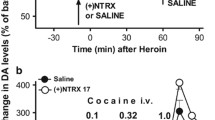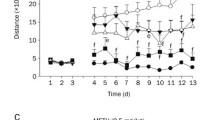Abstract
Rationale: It has been inferred from indirect tests that MK-801, an NMDA receptor antagonist, blocks sensitization to amphetamine and to morphine. These inferences were made from studies where behavioral scores were not recorded after each drug treatment in the sensitization protocol. Objectives: We reinvestigated the role of NMDA receptors in sensitization to amphetamine or morphine more directly by taking locomotor and stereotypy scores after each of several treatments with MK-801 and amphetamine or morphine. Methods: Each male Long Evans rat was administered intraperitoneal injections of MK-801 (0.1 or 0.25 mg/kg) or saline followed 30 minutes later by amphetamine (0.75 mg/kg), morphine (1.25 mg/kg) or saline and placed immediately in a photocell chamber. Locomotion and stereotypy were measured simultaneously by photobeam breaks and direct observation, respectively. This procedure was repeated on days 1, 2, 3, 4, 5, 8, 11 and 27 for rats receiving amphetamine or saline as the second injection and on days 1–10, 13, 16 and 32 for rats receiving morphine or saline as their second injection (with no testing or treatment on intervening days). Results: The animals treated in the amphetamine condition and animals treated in the morphine condition all showed progressively greater locomotion and stereotypy over the first 5 (amphetamine) or 10 (morphine) test days; the sensitized response was seen regardless of whether the animals were pretreated with saline or with MK-801. Thus MK-801 failed to block the development of psychomotor sensitization seen with these treatment regimens. When, following initial sensitization, amphetamine or morphine was given in the absence of MK-801 (days 8 and 13 for amphetamine and morphine rats, respectively), there was no expression of the sensitized response; the sensitized response of animals previously treated in the MK-801 drug state was expressed only when the animal was tested in the MK-801 drug state. The sensitized response was still expressed, in animals tested in the appropriate drug condition, after a 2-week period in which no drugs were given, confirming that the changes underlying this form of sensitization were long-lasting and thus probably a consequence of some form of synaptic plasticity. Conclusions: Our data provide evidence that behavioral sensitization to amphetamine and to morphine can occur despite the presence of NMDA receptor blockade. These and previous findings suggest that the failure of expression of sensitization seen when MK-801 is withdrawn from a given psychomotor stimulant treatment regimen reflects, at least in part, the dependency of sensitization on the various conditions of training rather than dependency on some essential function of NMDA receptor activation.
Similar content being viewed by others
Author information
Authors and Affiliations
Additional information
Received: 14 October 1999 / Accepted: 7 March 2000
Rights and permissions
About this article
Cite this article
Ranaldi, R., Munn, E., Neklesa, T. et al. Morphine and amphetamine sensitization in rats demonstrated under moderate- and high-dose NMDA receptor blockade with MK-801 (dizocilpine). Psychopharmacology 151, 192–201 (2000). https://doi.org/10.1007/s002130000480
Issue Date:
DOI: https://doi.org/10.1007/s002130000480




